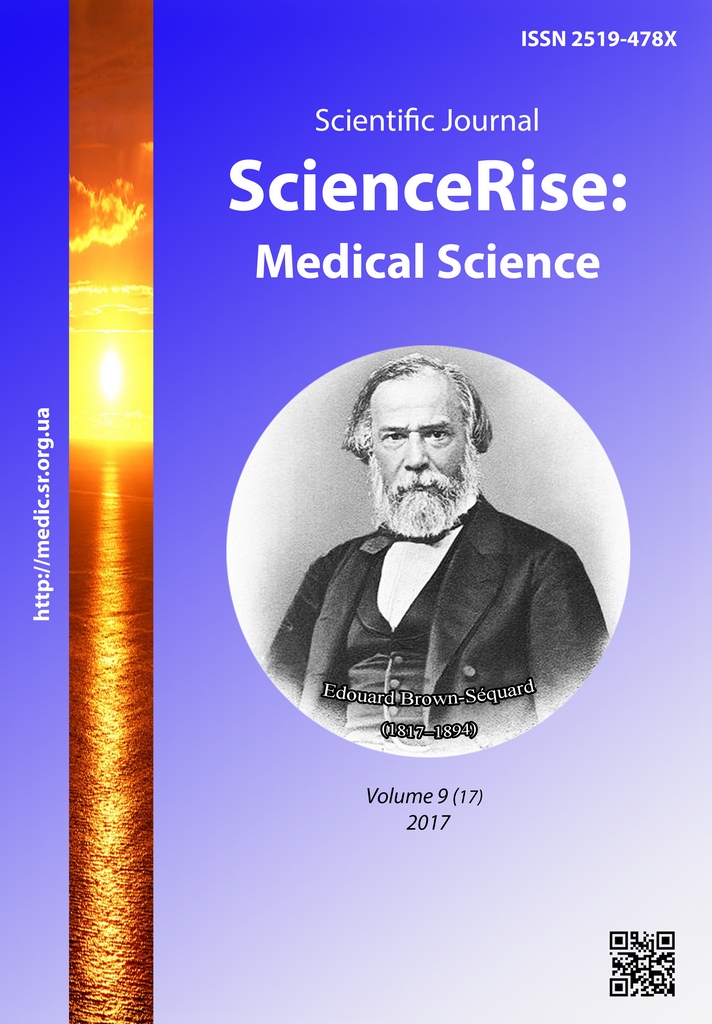Тригерне значення персистуючих внутрішньоклітинних збудників при тривалих лихоманках з подальшим розвитком соматичної патології у дітей
DOI:
https://doi.org/10.15587/2519-4798.2017.111190Ключові слова:
внутрішньоклітинні збудники, тривалі лихоманки, персистуюча інфекція, інтерлейкіни, місцеві чинники захисту, соматична патологіяАнотація
Особлива увага приділена персистуючій інфекції, викликаній внутрішньоклітинними збудниками, яка може бути чинником тривалих лихоманок, а також фоном, на якому формуються соматична патологія.
Клініко-анамнестичні, лабораторні дані й імунологічне дослідження дозволяють прогнозувати наслідки в катамнезі дітей із внутрішньоклітинними інфекціями різної соматичної патології та надають можливості для розробки нових діагностичних критеріїв
Посилання
- Yeloyeva, Z. V., Akinina, M. N., Belovodskaya, I. V., Usenko, M. S. (2013). An atypically infectious pathology in children caused by intracellular pathogens. Kharkiv Medical Journal, 1, 31–35.
- Yeloyeva, Z. V., Akinina, M. N., Belovodskaya, I. V. (2013). The value of intracellular pathogens in LDL in children. Epidemiology, hygiene, infectious diseases, 1 (8), 55–58.
- Delyagin, V. M. (2012). Fever Variety of reasons and complexity of decision. Health of the child, 6, 171–176.
- Yeloyeva, Z. V., Krasnozhen, N. N., Diachenko, M. S. (2014). Features of the course of an atypically leaky pathology caused by persistent intracellular infections. Kharkiv: "Opinion", 29–32.
- Bogadel'nikov, I. V., Krueger, E. A., Bobrysheva, A. V., Smirnov, G. I. (2012). Do not hide the infection in your pocket. Health of the child, 8 (43), 143–145.
- Kopcha, V. S., Legeza, K. M. (2011). Long subfebrile and fever of unclear genesis. Infectious Diseases, 3, 59–74.
- Akinina, M. N., Eloeva, Z. V., Kuznetsova, V. M., Shevchenko, Y. A., Korzhova, A. V. (2015). The role of streptococcal infection in the occurrence of fever in unclear genesis in children. Kharkiv: Generous Estate Plus, 17–19.
- Yeloyeva, Z. V., Mishhenko, V. A., Akinina, M. N., Belovodskaya, I. V. (2014). Improvement of Diagnosis and Forecasting of Complications in Children with fever of unknown origin. Epidemiology, hygiene, infectious diseases, 2, 31–38.
- Yulish, E. I. (2009) Persistent infections and man. Strategy of mutual relations. Child's health, 4 (19), 106–117.
- García-Sastre, A. (2017). Ten Strategies of Interferon Evasion by Viruses. Cell Host & Microbe, 22 (2), 176–184. doi: 10.1016/j.chom.2017.07.012
- Barron, K., Athreya, B., Kastner, D. (2011). Periodic fever syndromes and other inherited autoinflammatory diseases. Textbook of Pediatric Rheumatology, 642–660. doi: 10.1016/b978-1-4160-6581-4.10043-3
- Xu, L., Zhu, Y., Ren, L., Xu, B., Liu, C., Xie, Z., Shen, K. (2017). Characterization of the nasopharyngeal viral microbiome from children with community-acquired pneumonia but negative for Luminex xTAG respiratory viral panel assay detection. Journal of Medical Virology. doi: 10.1002/jmv.24895
- Kawai, Y., Miyashita, N., Kato, T., Okimoto, N., Narita, M. (2016). Extra-pulmonary manifestations associated with Mycoplasma pneumoniae pneumonia in adults. European Journal of Internal Medicine, 29, e9–e10. doi: 10.1016/j.ejim.2015.11.011
- Wishaupt, J. O., Versteegh, F. G. A., Hartwig, N. G. (2015). PCR testing for Paediatric Acute Respiratory Tract Infections. Paediatric Respiratory Reviews, 16 (1), 43–48. doi: 10.1016/j.prrv.2014.07.002
- Fujieda, M., Tsuruga, K., Sato, T., Kikuchi, H., Tamaki, W., Ishihara, M. et. al. (2016). Monitoring of Epstein–Barr virus load and killer T cells in patients with juvenile idiopathic arthritis treated with methotrexate or tocilizumab. Modern Rheumatology, 27 (1), 66–71. doi: 10.1080/14397595.2016.1177247
- Kim, Y.-S., Kim, K.-R., Kang, J.-M., Kim, J.-M., & Kim, Y.-J. (2017). Etiology and clinical characteristics of fever of unknown origin in children: a 15-year experience in a single center. Korean Journal of Pediatrics, 60(3), 77. doi: 10.3345/kjp.2017.60.3.77
- Yulish, E. I. (2010). Paradigm of the formation and development of chronic somatic diseases against the background of persistent infections. Health of the child, 6 (27), 92–101.
##submission.downloads##
Опубліковано
Як цитувати
Номер
Розділ
Ліцензія
Авторське право (c) 2017 Sergey Matvienko, Marina Diachenko

Ця робота ліцензується відповідно до Creative Commons Attribution 4.0 International License.
Наше видання використовує положення про авторські права Creative Commons CC BY для журналів відкритого доступу.
Автори, які публікуються у цьому журналі, погоджуються з наступними умовами:
1. Автори залишають за собою право на авторство своєї роботи та передають журналу право першої публікації цієї роботи на умовах ліцензії Creative Commons CC BY, котра дозволяє іншим особам вільно розповсюджувати опубліковану роботу з обов'язковим посиланням на авторів оригінальної роботи та першу публікацію роботи у цьому журналі.
2. Автори мають право укладати самостійні додаткові угоди щодо неексклюзивного розповсюдження роботи у тому вигляді, в якому вона була опублікована цим журналом (наприклад, розміщувати роботу в електронному сховищі установи або публікувати у складі монографії), за умови збереження посилання на першу публікацію роботи у цьому журналі.










